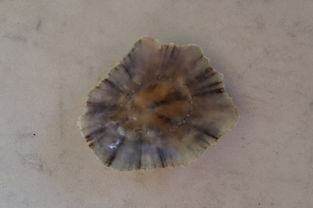Spirographs (polychaetes) and Molluscs
Spirographs (Sabella spallanzanii): These are polychaetes or tube worms. Really strange animals that live in a tube attached to a rock and deploy a plume that undulates with the waves. At the slightest alarm, they retract the plume into the tube! This plume helps them filter the water to feed. Around Ste Maxime I only saw one kind, but I saw blue and yellow ones elsewhere.
Molluscs: (Octopuses and cuttlefish are also molluscs and are the subject of a separate page.)
There are certainly many more kinds of mollusks but they are difficult to see and identify, so I put here some observations that I was able to make.
The great mother-of-pearl (Pinna nobilis) used to be visible in the Posidonia but have disappeared. They are now protected and boats are forbidden from anchoring there, so I hope they will reappear. They are the largest crustaceans in the Mediterranean; they can reach 1 meter.
Abalone (Haliotis tuberculata): Gerry finds these mainly around octopus "holes." We think octopuses find them under rocks, eat them, and bring them back to their holes to include in their fortifications. An octopus once prevented Gerry from taking "his" abalone by sending out a tentacle to shove it into his hole! Abalone have a beautiful pearly finish, and some people use them to make jewelry.
Limpets (Patella ulyssiponensis, for the "common" one, Patella rustica for the "pointed" one): They are also called arapedes in the south. They are difficult to identify exactly because they are often covered in algae.
Sea snails: Also difficult to see and identify. In the photos, one of the Gibbule type (Phorcus turbinatus, perhaps) and a larger one.
Mediterranean mussels (Mytilus galloprovincialis): I see them quite rarely.
Spirograph films returning to their tube, at La Croisette in 2025
Thanks to my "assistant," Sacha, I was able to film this spirograph, which retracts into its tube when touched. It will pop back out after a few minutes.












